By Leen Randell
Updated: Jul 04, 2024
10 Best Herbal Decoctions For Dry Skin
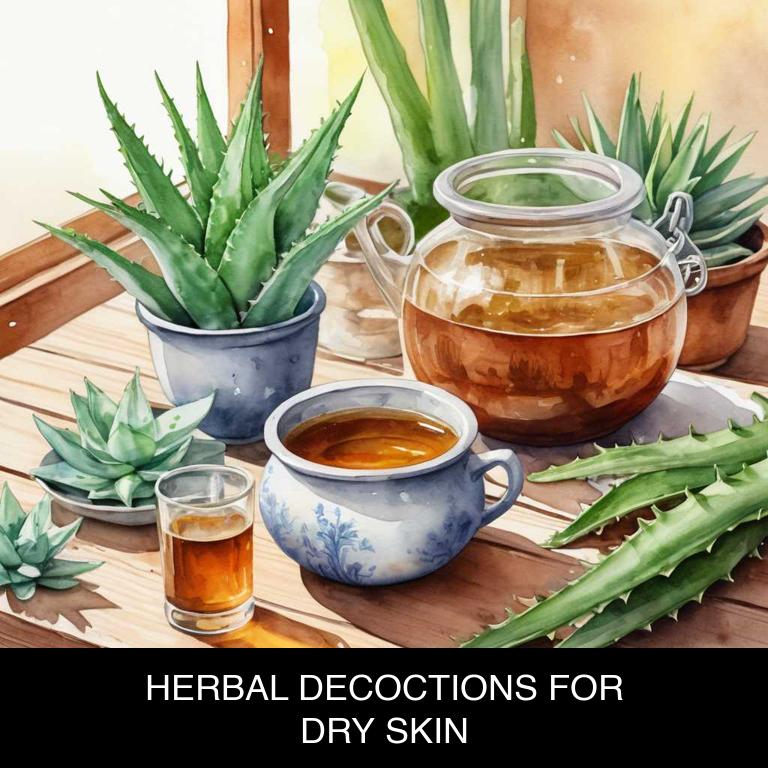
Herbal decoctions for dry skin are a natural remedy that involves steeping herbs in hot water to create a liquid extract that helps to soothe, moisturize, and nourish dry skin.
These decoctions can help to lock in moisture, reduce inflammation, and improve skin elasticity, making them an effective treatment for dry, itchy, and flaky skin. Examples of herbal decoctions that benefit dry skin include chamomile, calendula, and marshmallow root, which can be consumed as a tea or applied topically as a mask.
By using these decoctions, individuals with dry skin can enjoy softer, more radiant complexions that feel comfortable and healthy, improving their overall sense of well-being and confidence.
The following article describes in detail the most important decoctions for dry skin, including medicinal properties, parts of herbs to use, and recipes for preparations.
- 1. Aloe vera
- 2. Calendula officinalis
- 3. Matricaria chamomilla
- 4. Althaea officinalis
- 5. Lavandula angustifolia
- 6. Arctium lappa
- 7. Taraxacum officinale
- 8. Glycyrrhiza glabra
- 9. Stellaria media
- 10. Plantago major
- What is the best combination of herbal decoctions to use for dry skin?
- What ailments similar to dry skin are treated with herbal decoctions?
1. Aloe vera
Aloe decoctions helps with dry skin because of its rich anti-inflammatory and moisturizing properties.
The gel-like substance extracted from the aloe leaf contains vitamins, minerals, and amino acids that deeply nourish and hydrate the skin. When used as a decoction, these beneficial compounds are released into the water, allowing for a gentle and effective treatment of dry skin.
Regular use can help to lock in moisture, reduce redness and irritation, and leave skin feeling soft, supple, and refreshed.

Medicinal Constituents
The list below shows the primary medicinal constituents in Aloe vera decoctions that help with dry skin.
- Glucomannans: These polysaccharides help retain moisture in the skin, reducing dryness and promoting hydration.
- Vitamins: These antioxidants protect the skin from damage caused by free radicals, promoting skin health and reducing dryness.
- Aldehydes: These compounds exhibit anti-inflammatory properties, reducing redness and irritation associated with dry skin.
Parts Used
The list below shows the primary parts of aloe used to make decoctions for dry skin.
- Leaves: The leaves of Aloe vera are most commonly used due to their high gel content, which is rich in vitamins, minerals, and antioxidants that help to moisturize and soothe dry skin.
- Stems: The stems of Aloe vera contain a higher concentration of aloe-emodin, a compound that has anti-inflammatory properties, making them useful for treating dry skin irritations.
- Seeds: Aloe vera seeds contain a high amount of fatty acids and vitamins that help to nourish and moisturize dry skin, making them a popular ingredient in skincare decoctions.
Quick Recipe
The following recipe gives a procedure to make a basic aloe for dry skin.
- Harvest fresh aloe vera leaves in the early morning or late afternoon for optimal potency and flavor.
- Wash the harvested leaves thoroughly with cold water to remove any dirt or debris.
- Chop the leaves into small pieces to increase their surface area for better extraction.
- Combine the chopped aloe vera with 1 cup of boiling water to create a decoction.
- Steep the mixture for 10-15 minutes before straining and serving as a soothing drink.
2. Calendula officinalis
Pot marigold decoctions helps with dry skin because of its rich antioxidant and anti-inflammatory properties.
The decoction's ability to soothe and calm irritated skin, while also promoting collagen production, can help to alleviate dryness and discomfort. Additionally, the vitamin A and E content in pot marigold can help to repair and regenerate the skin, leaving it feeling softer, smoother, and more supple.
This natural remedy is a gentle and effective way to combat dry skin, providing long-lasting relief and hydration.

Medicinal Constituents
The list below shows the primary medicinal constituents in Calendula officinalis decoctions that help with dry skin.
- Carotenoids: These yellow, orange, and red pigments, particularly beta-carotene, help with dry skin by protecting the skin from damage and promoting the regeneration of skin cells.
- Flavonoids: Specifically, flavonoids like kaempferol and quercetin, exhibit anti-inflammatory properties, which help to soothe and calm dry skin, reducing redness and irritation.
- Naphthoquinones: This compound has been shown to exhibit antioxidant and anti-inflammatory properties, which can help to reduce inflammation and promote the healing of dry skin, while also protecting the skin from further damage.
Parts Used
The list below shows the primary parts of pot marigold used to make decoctions for dry skin.
- Flowers: The flowers of Calendula officinalis are the most commonly used part to make decoctions for dry skin due to their high content of antiseptic and anti-inflammatory compounds.
- Leaves: The leaves are also used to make decoctions for dry skin as they contain antioxidants and other beneficial compounds that help soothe and moisturize the skin.
- Seeds: The seeds of Calendula officinalis are used in decoctions for dry skin due to their rich source of essential fatty acids and other nutrients that promote skin health.
Quick Recipe
The following recipe gives a procedure to make a basic pot marigold for dry skin.
- Gently harvest fresh flowers from the calendula officinalis plant in the morning when the petals are fully open.
- Dry the harvested calendula flowers in a warm place with good air circulation for 1 to 2 weeks.
- Measure out 1 teaspoon of dried calendula flowers for every 1 cup of water to be used.
- Combine the dried calendula flowers with boiling water in a saucepan and steep for 5 to 10 minutes.
- Strain the mixture through a cheesecloth or fine-mesh sieve into a clean container to remove the solids.
3. Matricaria chamomilla
Chamomile decoctions helps with dry skin because of its soothing and anti-inflammatory properties.
The antioxidants present in chamomile help to calm irritated skin, reducing redness and discomfort. Additionally, chamomile's moisturizing effects help to lock in moisture, leaving skin feeling soft and supple. This natural remedy is especially beneficial for individuals with eczema or psoriasis, as it can help to reduce inflammation and promote healing without harsh chemicals.
Regular use of chamomile decoctions can leave skin looking healthy, smooth, and refreshed.

Medicinal Constituents
The list below shows the primary medicinal constituents in Matricaria chamomilla decoctions that help with dry skin.
- Apigenin: This flavonoid has anti-inflammatory and antioxidant properties that help soothe and calm dry, irritated skin, reducing redness and discomfort.
- Α-bisabolol: As a terpene, it possesses moisturizing and protective properties that help lock in moisture, reducing dryness and promoting skin hydration.
- Chamazulene: This phenolic compound has anti-inflammatory and antioxidant effects that help reduce inflammation and protect the skin from further damage, promoting a healthy skin barrier and reducing dryness.
Parts Used
The list below shows the primary parts of chamomile used to make decoctions for dry skin.
- Flowers: The flowers of Matricaria chamomilla are used to make decoctions for dry skin because of their high content of soothing and anti-inflammatory compounds, such as apigenin and luteolin.
- Seeds: The seeds of Matricaria chamomilla are used to make decoctions for dry skin due to their rich oil content, which provides moisturizing and protective properties to dry skin.
- Leaves: The leaves of Matricaria chamomilla are used to make decoctions for dry skin because of their astringent and anti-inflammatory properties, which help to soothe and calm dry skin.
Quick Recipe
The following recipe gives a procedure to make a basic chamomile for dry skin.
- Harvest 20-30 matricaria chamomilla flowers on a dry sunny morning for optimal potency and flavor.
- Dry the freshly harvested flowers in a warm place for 7-10 days or using a food dehydrator.
- Steep 1 teaspoon of dried flowers in 1 cup of boiling water for 5-7 minutes.
- Strain the decoction through a fine-mesh sieve into a clean container to remove the solids.
- Store the cooled decoction in the refrigerator for up to 3 days or freeze for later use.
4. Althaea officinalis
Marshmallow decoctions helps with dry skin because they contain a unique combination of mucilages, saponins, and flavonoids that work together to soothe and calm irritated skin.
The mucilages create a protective barrier on the skin's surface, locking in moisture and reducing water loss, while the saponins gently cleanse and purify the skin without stripping it of its natural oils.
Additionally, the flavonoids have potent anti-inflammatory properties that help to reduce redness and itching associated with dry skin, leaving skin feeling soft, supple, and refreshed.

Medicinal Constituents
The list below shows the primary medicinal constituents in Althaea officinalis decoctions that help with dry skin.
- Mucilages: Mucilages help to soothe and moisturize dry skin by forming a protective barrier on the skin's surface, reducing inflammation and promoting hydration.
- Gallic acid: Gallic acid has anti-inflammatory and antioxidant properties that help to reduce redness and irritation associated with dry skin, promoting a healthy skin environment.
- Althaea flavonoids: Althaea flavonoids, particularly kaempferol and quercetin, possess antioxidant and anti-inflammatory properties that help to protect the skin from damage, promote collagen production, and improve skin hydration.
Parts Used
The list below shows the primary parts of marshmallow used to make decoctions for dry skin.
- Roots: Rich in mucilage, a soothing and protective substance that helps to hydrate and calm dry skin.
- Leaves: Contain anti-inflammatory properties that can help to reduce redness and irritation associated with dry skin.
- Barks: Rich in antioxidants and mucilage, helping to protect and soothe dry, irritated skin while promoting skin health.
Quick Recipe
The following recipe gives a procedure to make a basic marshmallow for dry skin.
- Gather 30-60 grams of dried root of althaea officinalis and rinse it with cold water.
- Combine the rinsed root with 500 milliliters of water in a saucepan and bring to boil.
- Reduce heat to simmer and cook for 10-20 minutes or until the liquid is reduced.
- Strain the decoction through a cheesecloth or fine mesh to remove the solids.
- Store the cooled decoction in an airtight container in the refrigerator for up to 3 days.
5. Lavandula angustifolia
English lavender decoctions helps with dry skin because its antiseptic and anti-inflammatory properties soothe and calm irritated skin, reducing redness and discomfort.
The decongestant properties of lavender also help to reduce puffiness and tightness, while its moisturizing qualities leave the skin feeling soft, smooth, and supple.
Additionally, lavender's ability to regulate sebum production helps to balance the skin's natural moisture levels, providing long-lasting relief from dry, itchy skin.
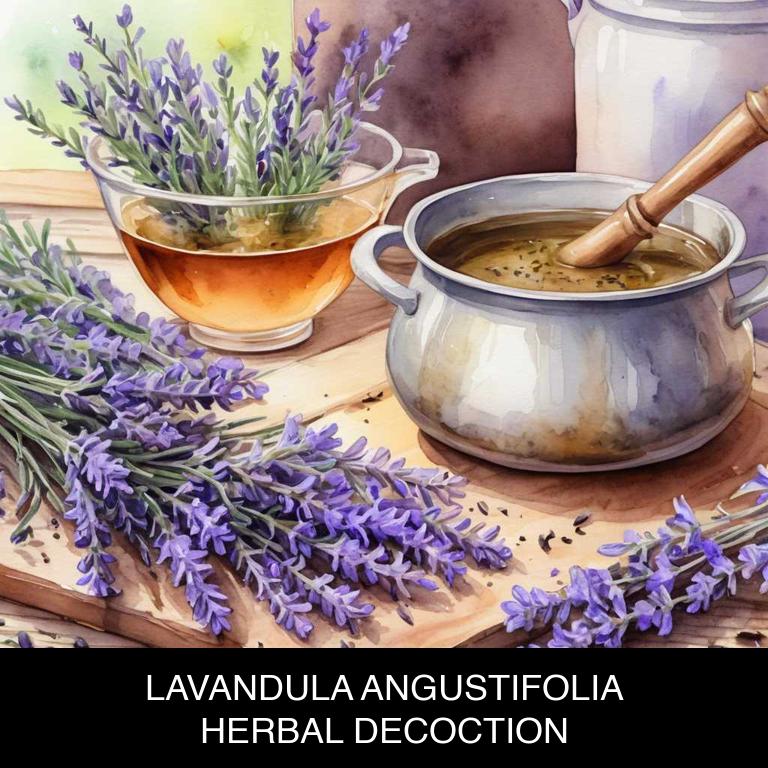
Medicinal Constituents
The list below shows the primary medicinal constituents in Lavandula angustifolia decoctions that help with dry skin.
- Linalool: This terpene helps to reduce inflammation and promote skin hydration, thereby alleviating dry skin symptoms.
- Lavandulol: This terpene possesses antioxidant and anti-inflammatory properties, which can help to repair and soothe dry, damaged skin.
- Apigenin: This phenolic compound has anti-inflammatory and antioxidant effects, which can help to calm and hydrate dry skin, reducing irritation and discomfort.
Parts Used
The list below shows the primary parts of english lavender used to make decoctions for dry skin.
- Leaves: The leaves of Lavandula angustifolia are used to make decoctions for dry skin because they contain antioxidants and volatile oils that help soothe and moisturize the skin.
- Flowers: The flowers of Lavandula angustifolia are used to make decoctions for dry skin because they are rich in calming and anti-inflammatory properties that help reduce skin irritation and inflammation.
- Stems: The stems of Lavandula angustifolia are used to make decoctions for dry skin because they contain a high concentration of antiseptic and antifungal compounds that help protect the skin from infections.
Quick Recipe
The following recipe gives a procedure to make a basic english lavender for dry skin.
- Harvest 2 ounces of dried lavandula angustifolia flowers from a trusted supplier at any time of the year.
- Combine 1 cup of boiling water with 1 teaspoon of dried lavandula angustifolia flowers in a heat-resistant cup.
- Steep the mixture for 5 to 7 minutes to allow the active ingredients to infuse into the water.
- Strain the liquid through a fine-mesh sieve into a clean cup to remove the solids.
- Store the cooled decoction in the refrigerator for up to 2 days or freeze for later use.
6. Arctium lappa
Burdock decoctions helps with dry skin because of its rich antioxidant and anti-inflammatory properties.
The decoction is able to penetrate deep into the skin, providing intense hydration and soothing dryness. It also contains beta-carotene, a powerful antioxidant that helps to repair and protect the skin from environmental stressors. Additionally, burdock has been shown to improve circulation and reduce inflammation, which can further help to alleviate dry skin symptoms.
Regular use of burdock decoctions can leave skin feeling soft, supple, and rejuvenated.
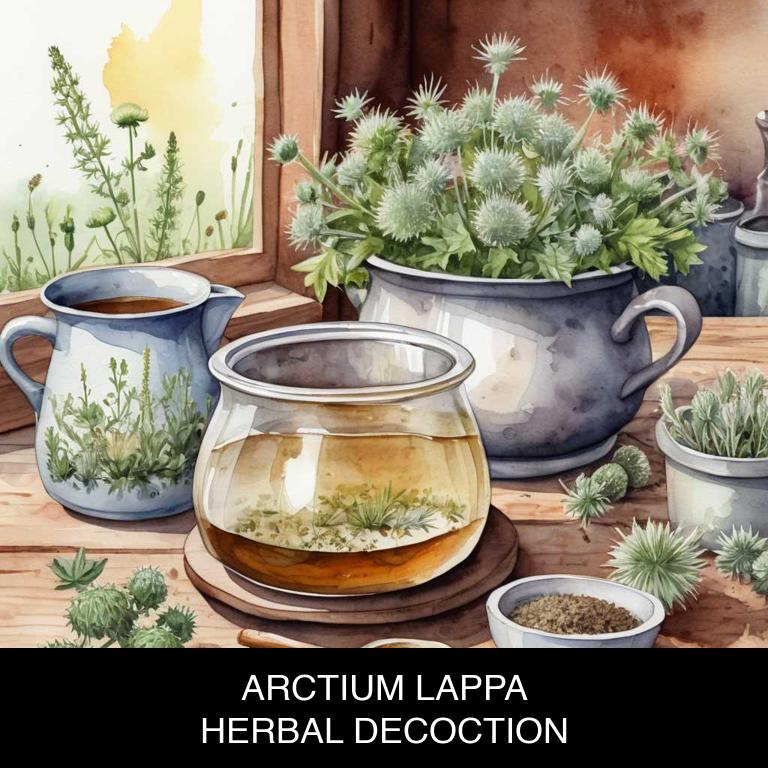
Medicinal Constituents
The list below shows the primary medicinal constituents in Arctium lappa decoctions that help with dry skin.
- Phenolic acids: Help with dry skin by exerting anti-inflammatory and antioxidant properties, reducing inflammation and damage caused by free radicals, and promoting skin health and hydration.
- Flavonoids: Help with dry skin by exhibiting antioxidant and anti-inflammatory activities, protecting the skin from damage, promoting collagen synthesis, and enhancing skin elasticity and hydration.
- Saponins: Help with dry skin by forming a protective barrier on the skin's surface, retaining moisture, and soothing dryness and irritation, while also possessing anti-inflammatory properties to calm skin conditions.
Parts Used
The list below shows the primary parts of burdock used to make decoctions for dry skin.
- Roots: They are used due to their high content of mucilages, which provide soothing and moisturizing properties for dry skin.
- Leaves: They are used for their anti-inflammatory and antioxidant properties, which help to reduce skin irritation and promote skin health.
- Seeds: They are used due to their oil content, which can help to lock in moisture and protect the skin from dryness and irritation.
Quick Recipe
The following recipe gives a procedure to make a basic burdock for dry skin.
- Gather 30 grams of dried root and wash it thoroughly with cold water to remove any impurities.
- Chop the root into small pieces to increase its surface area and facilitate extraction.
- Combine the root pieces with 500 milliliters of cold water in a saucepan and bring to a boil.
- Reduce the heat to a simmer and let the mixture steep for 15 to 20 minutes to allow for extraction.
- Strain the decoction through a cheesecloth or a fine-mesh sieve into a clean container to remove the solids.
7. Taraxacum officinale
Dandelion decoctions helps with dry skin because it is rich in antioxidants, vitamins, and minerals that deeply moisturize and nourish the skin.
The diuretic properties of dandelion also help to flush out toxins and excess fluids from the body, which can contribute to dryness and irritation. Additionally, dandelion's anti-inflammatory compounds soothe and calm the skin, reducing redness and itchiness.
By incorporating dandelion decoctions into a skincare routine, individuals with dry skin may experience improved hydration, reduced flakiness, and a healthier overall complexion.

Medicinal Constituents
The list below shows the primary medicinal constituents in Taraxacum officinale decoctions that help with dry skin.
- Taraxasterol: It helps with dry skin by reducing inflammation and improving skin hydration due to its anti-inflammatory and emollient properties.
- Inulin: It helps with dry skin by providing moisturizing and soothing effects, reducing skin dryness and promoting skin elasticity.
- Quercetin: It helps with dry skin by reducing oxidative stress and inflammation, thereby improving skin hydration and reducing the appearance of fine lines and wrinkles.
Parts Used
The list below shows the primary parts of dandelion used to make decoctions for dry skin.
- Roots: They are rich in inulin, a prebiotic that helps to soothe and moisturize dry skin.
- Leaves: They contain flavonoids and terpenes that have anti-inflammatory and antioxidant properties, which help to calm dry skin irritations.
- Seeds: They are a good source of fatty acids, particularly linoleic acid, which can help to lock in moisture and nourish dry skin.
Quick Recipe
The following recipe gives a procedure to make a basic dandelion for dry skin.
- Harvest the plant's leaves and roots when they are fresh and in high moisture content for better medicinal properties.
- Cleanse the collected plant material with cold running water to remove any dirt or debris.
- Dry the plant material in a warm well-ventilated area for several days to reduce moisture content.
- Combine 1 part of the dried plant material with 2 parts of boiling water to make a decoction.
- Steep the mixture for 5 to 10 minutes and then strain it to obtain the herbal decoction.
8. Glycyrrhiza glabra
Licorice decoctions helps with dry skin because it contains glycyrrhizin, a compound that has anti-inflammatory properties.
This soothes and calms irritated skin, reducing redness and discomfort. Additionally, licorice root is rich in antioxidants and flavonoids, which help to protect the skin from environmental stressors and damage caused by free radicals.
By promoting hydration and collagen production, herbal licorice decoctions can leave dry skin feeling soft, supple, and nourished, providing a natural solution for managing dry, flaky skin.

Medicinal Constituents
The list below shows the primary medicinal constituents in Glycyrrhiza glabra decoctions that help with dry skin.
- Glycyrrhizin: This triterpenoid saponin acts as a skin moisturizer, helping to lock in moisture and protect the skin from dryness.
- Liquiritigenin: This isoflavone has anti-inflammatory and antioxidant properties, which can help soothe and calm dry, irritated skin.
- Licoricidin: This phenolic glycoside has anti-inflammatory and anti-itch properties, which can help reduce redness, itching, and dryness associated with skin conditions.
Parts Used
The list below shows the primary parts of licorice used to make decoctions for dry skin.
- Roots: Glycyrrhiza glabra roots are commonly used to make decoctions for dry skin due to their rich content of glycyrrhizin, which has moisturizing and anti-inflammatory properties.
- Leaves: The leaves of Glycyrrhiza glabra are also used to make decoctions for dry skin, as they contain compounds that help to soothe and calm irritated skin.
- Barks: Glycyrrhiza glabra barks are used in decoctions for dry skin due to their ability to provide a protective barrier and lock in moisture, helping to alleviate dryness and irritation.
Quick Recipe
The following recipe gives a procedure to make a basic licorice for dry skin.
- Harvest 30 grams of dried glycyrrhiza glabra roots and clean them thoroughly with water.
- Weigh and combine 10 grams of the dried roots with 1 liter of boiling distilled water.
- Steep the mixture for 30 to 40 minutes to allow the active compounds to infuse.
- Strain the decoction through a cheesecloth or a fine mesh to remove the solids.
- Store the final decoction in a glass container and refrigerate it at 4 degrees celsius.
9. Stellaria media
Chickweed decoctions helps with dry skin because of its unique combination of nutrients and antioxidants.
The decoction is rich in vitamins A, C, and E, as well as omega-3 fatty acids, which work together to deeply moisturize and nourish the skin. Additionally, chickweed's anti-inflammatory properties help reduce redness and irritation, leaving dry skin feeling soft, supple, and hydrated.
Regular use of chickweed decoctions can also improve skin elasticity and firmness, making it an effective natural remedy for addressing dry skin concerns.
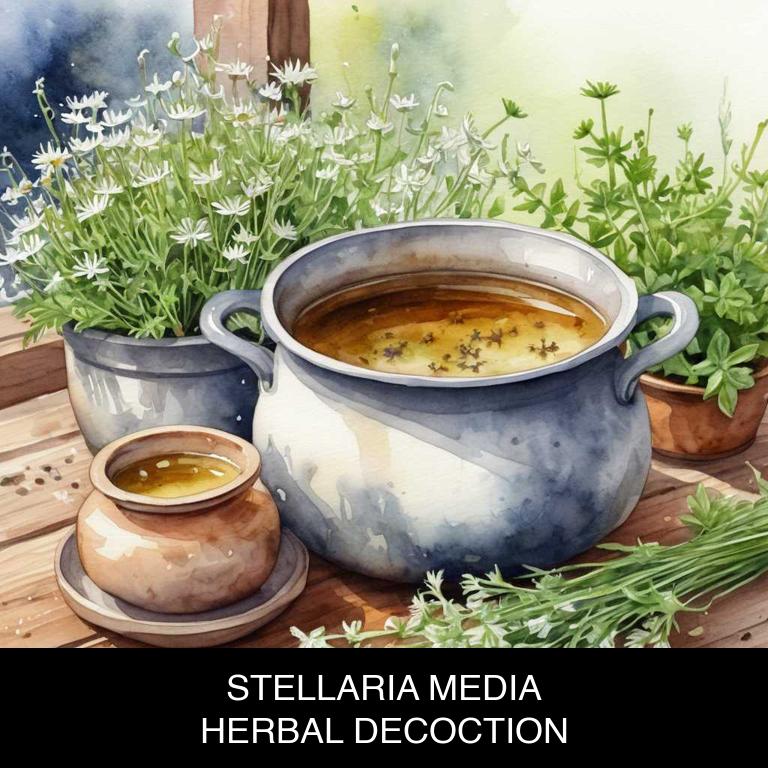
Medicinal Constituents
The list below shows the primary medicinal constituents in Stellaria media decoctions that help with dry skin.
- Flavonoids: These plant-based compounds have antioxidant and anti-inflammatory properties, which may help soothe and protect dry skin from damage caused by free radicals and inflammation.
- Saponins: These natural surfactants can help to moisturize and soften dry skin by creating a barrier that retains moisture and reduces water loss.
- Tannins: These astringent compounds can help to reduce inflammation and itching associated with dry skin, while also providing a protective barrier to prevent further moisture loss.
Parts Used
The list below shows the primary parts of chickweed used to make decoctions for dry skin.
- Leaves: The leaves of Stellaria media contain mucilages, which help to soothe and moisturize dry skin.
- Flowers: The flowers of Stellaria media are a rich source of antioxidants and have anti-inflammatory properties that aid in soothing dry skin.
- Roots: The roots of Stellaria media contain a high amount of mucilages, which help to hydrate and protect dry skin.
Quick Recipe
The following recipe gives a procedure to make a basic chickweed for dry skin.
- Gather 30-60 grams of dried stellaria media flowers and leaves from a trusted supplier.
- Combine the stellaria media with 1 liter of boiling water in a large glass container.
- Steep the mixture for 10-15 minutes to allow for maximum extraction of medicinal properties.
- Strain the decoction through a cheesecloth or a fine-mesh sieve into a separate container.
- Discard the solids and store the decoction in the refrigerator for up to 24 hours.
10. Plantago major
Plantain decoctions helps with dry skin because of its rich antioxidant and anti-inflammatory properties.
The decoction is believed to provide long-lasting hydration, soothing and calming irritated skin, while also reducing inflammation and redness. The plant's natural emollients work to fill in gaps between skin cells, locking in moisture and leaving skin feeling soft, supple, and nourished.
Regular use of herbal plantain decoctions can help to alleviate dryness, itchiness, and flakiness, revealing a more radiant and healthy complexion.
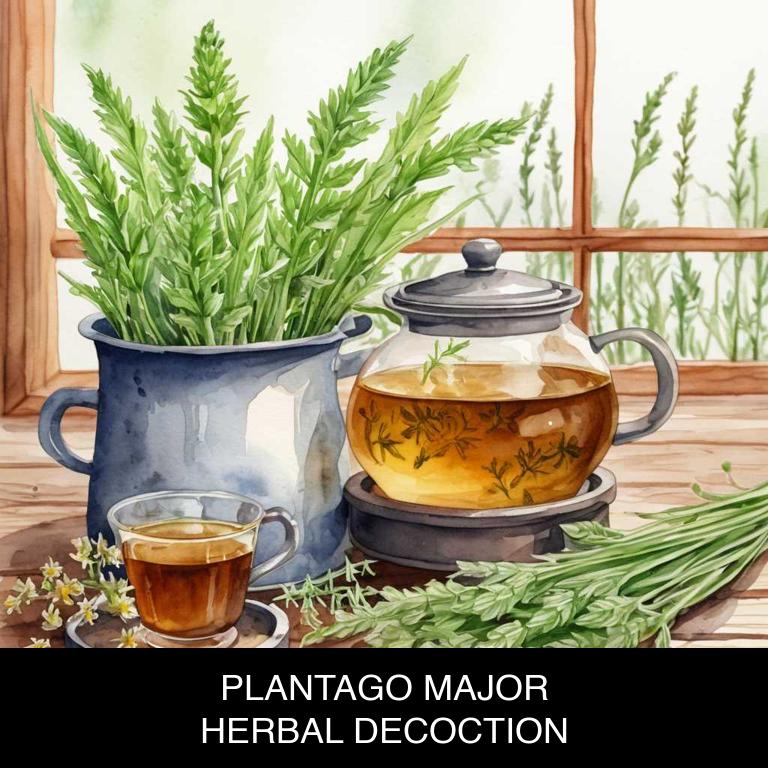
Medicinal Constituents
The list below shows the primary medicinal constituents in Plantago major decoctions that help with dry skin.
- Apolypodin: Helps to reduce inflammation and soothe dry skin due to its anti-inflammatory and antioxidant properties.
- Saponins: Moisturize and protect the skin by forming a protective barrier against water loss, thereby reducing dryness and discomfort.
- Phenolic acids: Exert antioxidant and anti-inflammatory effects, which may help to protect the skin from damage, reduce inflammation, and promote skin health.
Parts Used
The list below shows the primary parts of plantain used to make decoctions for dry skin.
- Leaves: Leaves are the most commonly used part due to their high mucilage content, which helps to moisturize and soothe dry skin.
- Stems: Stems of Plantago major are used for their anti-inflammatory properties, which aid in reducing redness and irritation associated with dry skin.
- Roots: Roots are used for their astringent properties, which help to tighten and protect the skin, reducing dryness and flakiness.
Quick Recipe
The following recipe gives a procedure to make a basic plantain for dry skin.
- Gather 20-30 grams of dried plantago major leaves and flowers.
- Rinse the dried herb with cold water to remove any impurities.
- Combine the rinsed herb with 1 liter of cold water in a saucepan.
- Bring the water to a boil then reduce heat and simmer for 10-15 minutes.
- Strain the decoction through a cheesecloth or a fine-mesh sieve into a clean container.
What is the best combination of herbal decoctions to use for dry skin?
The best combination of herbal decoctions that help with dry skin is a blend of calendula, chamomile, and aloe vera.
Calendula has anti-inflammatory properties that soothe and calm dry skin, while chamomile provides a calming effect and helps to reduce redness. Aloe vera, rich in vitamins and minerals, deeply moisturizes and hydrates the skin, leaving it soft and supple.
This combination works synergistically to provide long-lasting relief from dry skin, promoting healthy and radiant skin.
What ailments similar to dry skin are treated with herbal decoctions?
Ailments similar to dry skin that are treated with herbal decoctions are eczema, psoriasis, and acne.
Herbal decoctions can help soothe and calm irritated skin, reduce inflammation, and promote healing.
Decoctions made from herbs like calendula, chamomile, and licorice root have anti-inflammatory and antioxidant properties that can help to alleviate symptoms of these conditions and leave the skin feeling smooth and healthy.